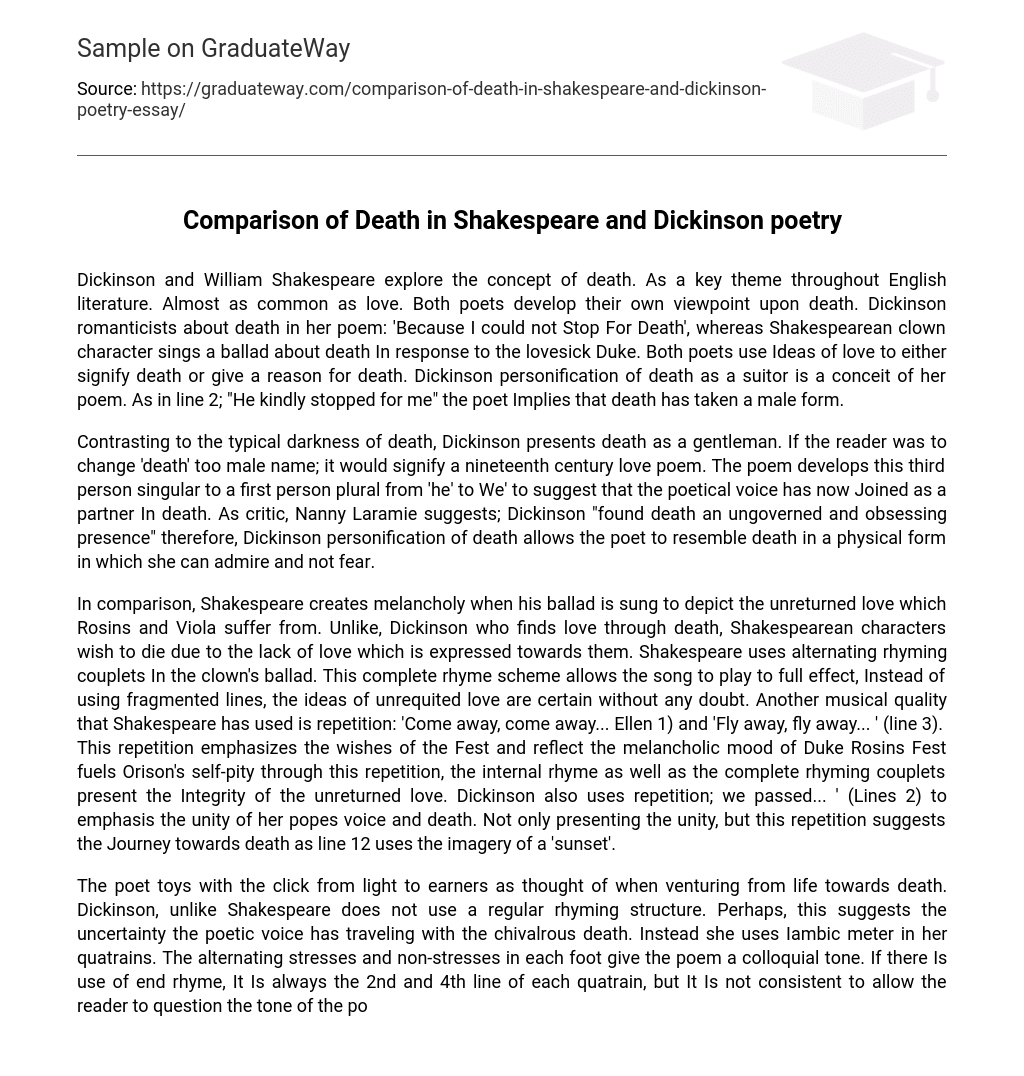Dickinson and William Shakespeare explore the concept of death. As a key theme throughout English literature. Almost as common as love. Both poets develop their own viewpoint upon death. Dickinson romanticists about death in her poem: ‘Because I could not Stop For Death’, whereas Shakespearean clown character sings a ballad about death In response to the lovesick Duke. Both poets use Ideas of love to either signify death or give a reason for death. Dickinson personification of death as a suitor is a conceit of her poem. As in line 2; “He kindly stopped for me” the poet Implies that death has taken a male form.
Contrasting to the typical darkness of death, Dickinson presents death as a gentleman. If the reader was to change ‘death’ too male name; it would signify a nineteenth century love poem. The poem develops this third person singular to a first person plural from ‘he’ to We’ to suggest that the poetical voice has now Joined as a partner In death. As critic, Nanny Laramie suggests; Dickinson “found death an ungoverned and obsessing presence” therefore, Dickinson personification of death allows the poet to resemble death in a physical form in which she can admire and not fear.
In comparison, Shakespeare creates melancholy when his ballad is sung to depict the unreturned love which Rosins and Viola suffer from. Unlike, Dickinson who finds love through death, Shakespearean characters wish to die due to the lack of love which is expressed towards them. Shakespeare uses alternating rhyming couplets In the clown’s ballad. This complete rhyme scheme allows the song to play to full effect, Instead of using fragmented lines, the ideas of unrequited love are certain without any doubt. Another musical quality that Shakespeare has used is repetition: ‘Come away, come away… Ellen 1) and ‘Fly away, fly away… ‘ (line 3). This repetition emphasizes the wishes of the Fest and reflect the melancholic mood of Duke Rosins Fest fuels Orison’s self-pity through this repetition, the internal rhyme as well as the complete rhyming couplets present the Integrity of the unreturned love. Dickinson also uses repetition; we passed… ‘ (Lines 2) to emphasis the unity of her popes voice and death. Not only presenting the unity, but this repetition suggests the Journey towards death as line 12 uses the imagery of a ‘sunset’.
The poet toys with the click from light to earners as thought of when venturing from life towards death. Dickinson, unlike Shakespeare does not use a regular rhyming structure. Perhaps, this suggests the uncertainty the poetic voice has traveling with the chivalrous death. Instead she uses Iambic meter in her quatrains. The alternating stresses and non-stresses in each foot give the poem a colloquial tone. If there Is use of end rhyme, It Is always the 2nd and 4th line of each quatrain, but It Is not consistent to allow the reader to question the tone of the poem and the lines which do and do not rhyme and what hat signifies.
Like Shakespeare, Dickinson enjoyed exploiting traditional conceptions of poetry, Unwilling to conform. She uses her tone of acceptance of death unlike poets of previous generations such as John Done, Abdul Wabash and even ‘ Off Shakespearean poem suggests that in death, you are alone. Unlike Dickinson, the poetic voice is always in the singular for example; “my poor corpse” (Line 12). This line reaches out for sympathy from the other characters suggesting that even in death as in life, Duke Rosins is isolated without company.
However, the request to “never [be] [o]ND” (Line 15) demonstrates how this isolation in death is a personal Journey. Contrasting the need for sympathy, the poetic voice does not request to be mourned over and waste the time of the living. This plea for death is a plea for the end, to end the pain of a love that does not love him back. However, Dickinson poetic voice does not see death as the end as Shakespearean does. Instead, the capitalized noun, “Immortality’ (Line 4) signifies that this Journey with death is leading to an afterlife. Which explains the poetic voice’s calmness at being accompanied by death.
Although he reader is to believe this poem is in the present tense, line 21 establishes that it was ‘centuries’ ago. So the poetic voice already has the power of immortality to live forever. In conclusion, Dickinson poetic voice is accustomed to being with the personified death as she explores the Journey beyond death (having died centuries ago). The concept of immortality allow the poet to romanticism this figure of death. Shakespeare uses the idea of failed romance to lead the Duke into his lonely grave. Unlike, Dickinson who has company in death, Shakespearean character is isolated and mortal.





